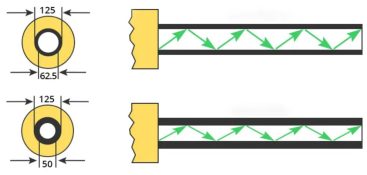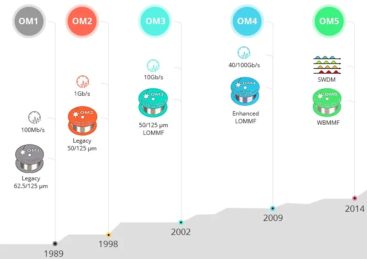OM1, OM2, OM3, OM4 և OM5 բազմամոդալ մանրաթելեր
Multimode մանրաթելը մանրաթելերի մի տեսակ է, որն օգտագործվում է կարճ հեռավորությունների փոխանցման համար, սովորաբար հանդիպում են համալսարանական ցանցերում, ձեռնարկությունների LAN-ներ, and data centers. Այսօր, the types of multimode fibers on the market are OM1, OM2, OM3, OM4, and OM5, all of which have different data transmission capabilities. With so many types of multimode fibers, do you wonder how to choose? This article will focus on the differences between OM1, OM2, OM3, OM4, and OM5 fibers, and I believe you will have a clearer understanding of the choice of multimode fibers after reading this article.

Types and differences of multimode fibers
Multimode fibers have a larger core diameter, typically 50 μm or 62.5 մկմ, and support multiple modes of light propagation compared to single-mode fibers, which are classified as OM1, OM2, OM3, OM4 and OM5 fibers according to ISO 11810.
- OM1 optical fiber refers to a multi-mode optical fiber with a bandwidth of more than 200/500MHz.km injected into the 850/1300nm window, which uses LED light source, the core diameter is 62.5μm, and the outer sheath is usually orange, which can be used for Ethernet below 10Gbps, and is most commonly used in 100 Gigabit Ethernet. Due to the large diameter of the OM1 core, it has strong light collection ability and bending resistance.
- OM2 optical fiber refers to a multi-mode optical fiber with a bandwidth of more than 500/500MHz.km injected into the 850/1300nmnm window, which uses LED light source, the core diameter is 50μm, and the outer sheath is usually orange, which can be used for Ethernet below 10Gbps, and is most commonly used in Gigabit Ethernet. Compared with OM1 fiber, OM2 fiber core diameter is reduced, which effectively reduces the mode dispersion of multimode fiber, increases bandwidth, and reduces the production cost by 1/3.
- OM3 fiber is a laser optimized multimode fiber, this kind of fiber uses 850nm VCSEL laser light source, the core diameter is 50μm, and the outer sheath is water blue, which can be used for Ethernet below 100Gbps, and is most commonly used in 10 Gigabit Ethernet. Compared with OM1 and OM2 fibers, OM3 has a higher transmission rate and bandwidth, so it is also called optimized multimode fiber or 10 Gigabit multimode fiber.
- OM4 optical fiber is an upgraded version of OM3 multimode optical fiber, with better performance, օրինակ, the effective bandwidth of OM4 optical fiber is more than double that of OM3 optical fiber, which is compatible with OM3 optical fiber, and the outer sheath is water blue. In Ethernet above 10Gbps, OM4 fiber transmits a longer distance than OM3 fiber, մինչեւ 400 մետր.
- OM5 fiber is a newly launched bandwidth multimode fiber, which is compatible with OM4 fiber, և դրա միջուկի տրամագիծը նույնն է, ինչ OM2/OM3/OM4 մանրաթելը (50մկմ), իսկ արտաքին պատյանը կրաքարի կանաչ է.

Վերջիվերջո, ամենամեծ տարբերությունը OM1-ի միջև, OM2, OM3, OM4 և OM5 բազմամոդալ մանրաթելերը ֆիզիկայի և կիրառման տարբերությունն են.
1. Ֆիզիկական տարբերություններ
Տարբեր բազմամոդալ մանրաթելեր ունեն տարբեր ֆիզիկական տարբերություններ, որոնք հիմնականում արտացոլվում են տրամագծով, արտաքին պատյանների գույնը, լույսի աղբյուր, և թողունակությունը, ինչպես ցույց է տրված հետևյալ աղյուսակում:
| Multimode մանրաթելերի տեսակը | Տրամագիծը | Արտաքին պատյանների գույնը | Օպտիկական աղբյուր | Թողունակություն |
| OM1 | 62.5/125մկմ | նարնջագույն | LED | 200ՄՀց * կմ |
| OM2 | 50/125մկմ | նարնջագույն | LED | 500ՄՀց * կմ |
| OM3 | 50/125մկմ | Ակվա կապույտ | VSCEL | 2000ՄՀց * կմ |
| OM4 | 50/125մկմ | Ակվա կապույտ | VSCEL | 4700ՄՀց * կմ |
| OM5 | 50/125մկմ | Լայմ կանաչ | VSCEL | 28000ՄՀց * կմ |
2. Դիմումների տարբերություններ
Տարբեր Ethernet ցանցերում մուլտիմոդալ օպտիկամանրաթելային ծրագրերը ապահովում են փոխանցման տարբեր առավելագույն հեռավորություններ, ինչպես ցույց է տրված հետևյալ աղյուսակում
| Մուլտիմոդալ մանրաթելերի տեսակները | Արագ Ethernet | 1G Ethernet | 10G Ethernet | 40G Ethernet | 100G Ethernet |
| OM1 | 2000Մ | 275Մ | 33Մ | / | / |
| OM2 | 2000Մ | 550Մ | 82Մ | / | / |
| OM3 | 2000Մ | 550Մ | 300Մ | 100Մ | 100Մ |
| OM4 | 2000Մ | 550Մ | 550Մ | 150Մ | 150Մ |
| OM5 | / | / | 550Մ | 440Մ | 150Մ |
Մշակման միտում և բազմամոդ օպտիկական մանրաթելերի կիրառում
Բարձր արագությամբ ցանցային հավելվածների պահանջարկի ներքո, մուլտիմոդի օպտիկական մանրաթելը զարգանում է ցածր կորստի ուղղությամբ, բարձր թողունակություն և բազմաալիքային մուլտիպլեքսավորում. Օպտիկամանրաթելային տեխնոլոգիայի շարունակական կատարելագործմամբ, մուլտիմոդալ մանրաթելն օրիգինալ OM1 մանրաթելից վերածվել է OM5 մանրաթելի, որն այժմ աջակցում է 40/100G ցանցերին:, և դրա կատարումն ավելի լավն է. Այսօր, OM1 և OM2 մուլտիմոդի մանրաթելերը հիմնականում օգտագործվում են տվյալների կենտրոններում 1G Ethernet կապի միացումների համար, OM3 և OM4 մուլտիմոդի մանրաթելերը հիմնականում օգտագործվում են 10G/40G տվյալների կենտրոնի մանրաթելային մալուխների համար, և OM5 մուլտիմոդալ մանրաթելերը հարմար են 40/100G բարձր արագությամբ Ethernet կապի փոխանցման համար. Համեմատած OM1/OM2/OM3/OM4 բազմամոդալ մանրաթելերի հետ, OM5 մուլտիմոդալ մանրաթելը շատ լայնածավալ է և ճկուն, ավելի քիչ միջուկներով ցանցի փոխանցման ավելի բարձր տեմպերի աջակցություն, and its cost and power consumption are much lower than that of singlemode fiber. It can be seen that OM5 multimode fiber may be widely used in 100G/400G/1T ultra-large data centers in the future.
Answers to frequently asked questions about multimode fiber
1. What is the difference between multimode fiber and singlemode fiber?
Core diameter: Multimode fibers have a large core diameter (typically 50/62.5μm) և կարող է փոխանցել լույսի մի քանի եղանակ. Single-mode fibers have a small core diameter (typically 9 մկմ) and can transmit only one mode of light. Թողունակություն: Single-mode fiber typically has a higher bandwidth than multimode fiber, մինչեւ 100,000 ԳՀց. Light source: LED light source is generally used for multimode optical fibers, while laser light sources are generally used for single-mode optical fibers. Հեռավորությունը: Multimode fiber is suitable for short-range applications, typically up to 550m in distance. Single-mode fiber is suitable for long-distance applications, and when the transmission distance is more than 550m, single-mode fiber is preferred. Cost: Multimode fiber is typically less expensive than singlemode fiber.
2. Multimode fiber connector type
Ներկայումս, common multi-mode optical fiber connectors (այսինքն., connectors) include ST, SC, ՖԿ, LC, IN, E2000, MTR, SMA, DIN and MTP&MPO, among which, Սբ, SC, ՖԿ, LC and MTP/MPO are the most commonly used types of optical fiber connectors. The pros, cons, and features of these five fiber optic connectors vary, so what are the differences between them? The following table lists the differences in ferrule size, insertion loss, և այլն. between ST, SC, ՖԿ, LC, and MTP/MPO connectors for multimode fibers
| Multimode Fiber Optic Connectors | Insert Size (Ceramic) | Տեղադրման կորուստ (դԲ) |
| SC | φ2.5mm | 0.25~0.5dB |
| LC | φ1.25mm | 0.25~0.5dB |
| ՖԿ | φ2.5mm | 0.25~0.5dB |
| Սբ | φ2.5mm | 0.25~0.5dB |
| MTP/MPO | φ2.5mm | 0.25~0.5dB |
Նշում: A ferrule refers to a precision-aligned cylinder in a fiber optic connector plug with a microhole in the center that is used to hold the fiber. According to the different materials used in the ferrule, it is divided into ceramic ferrule, glass ferrule, plastic ferrule and metal ferrule.
3. Advantages of multi-mode optical fiber
Despite the advantages of single-mode fiber in terms of bandwidth and transmission distance, multimode fiber can support the transmission distance requirements of most indoor applications and data centers at a fraction of the cost of installation and maintenance. Ի հավելումն, there are some significant advantages to multimode fiber, as described below:
Multi-user backbone network without loss-free interference: The biggest feature of multimode fiber is that it can carry multiple optical signals on the same link at the same time. What’s more, there is almost no loss of optical signal power. As a result, network users can send multiple packets at the same time in a multimode fiber patch cord, and all the information will be safely transmitted to the destination without any interference and will remain unchanged. Supports multiple protocols: Multimode fiber supports a variety of data transmission protocols, including Ethernet, unlimited bandwidth, and Internet Protocol. As a result, multimode fiber is seen as the foundation for core applications.
4. Can multimode fiber be used as single-mode?
Ոչ, because of the large dispersion and loss of multimode fibers, optical signals cannot be transmitted over long distances on multimode fibers.

